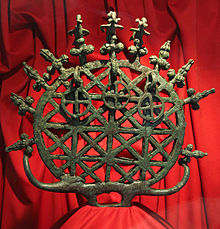
Back Bronstydperk Afrikaans Bronzezeit ALS ናስ ዘመን Amharic Edat de Bronce AN कांस्य युग ANP العصر البرونزي Arabic عصر برونزى ARZ ব্ৰঞ্জ যুগ Assamese Edá del bronce AST Tunc dövrü Azerbaijani

| Bronze Age |
|---|
| ↑ Chalcolithic |
| ↓ Iron Age |
| History of technology |
|---|
The Bronze Age (c. 3300 – c. 1200 BC) was a historical period characterised principally by the use of bronze tools and the development of complex urban societies, as well as the adoption of writing in some areas. The Bronze Age is the middle principal period of the three-age system, following the Stone Age and preceding the Iron Age.[1] Conceived as a global era, the Bronze Age follows the Neolithic, with a transition period between the two known as the Chalcolithic. The final decades of the Bronze Age in the Mediterranean basin are often characterised as a period of widespread societal collapse known as the Late Bronze Age collapse (c. 1200 – c. 1150 BC), although its severity and scope is debated among scholars.
An ancient civilisation is deemed to be part of the Bronze Age if it either produced bronze by smelting its own copper and alloying it with tin, arsenic, or other metals, or traded other items for bronze from producing areas elsewhere. Bronze Age cultures were the first to develop writing. According to archaeological evidence, cultures in Mesopotamia, which used cuneiform script, and Egypt, which used hieroglyphs, developed the earliest practical writing systems.
- ^ "The Metal Ages". Encyclopædia Britannica. 16 September 2024.